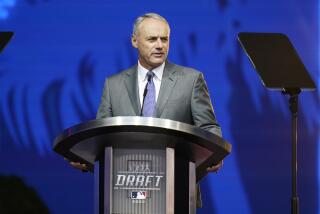No plans for nets
NEW YORK -- Commissioner Bud Selig said Tuesday he does not plan to mandate that clubs install protective netting beyond dugouts in order to protect fans from flying bats and balls.
As Selig awaits a report on ways to stem the epidemic of maple bats shattering and taking flight, he said he believes netting would not resolve the “root cause” of the problem and would not protect the people he considers most liable to be injured.
“The people most vulnerable are on the field and in the dugouts,” Selig said.
At least two fans have been seriously injured by fragments of maple bats. Donna Burk, seated behind the third base dugout and beyond reach of the netting behind home plate, was struck at PNC Park in Pittsburgh last year.
She suffered fractures to her forehead, nose, sinuses, eye socket and cheek, with surgeons putting six plates in her head and face, according to her attorney, Ed Balzarini Jr. She still has severe headaches and has not regained full sensation in her face, he said.
“I don’t think there’s any question, if there had been a net in the area she was sitting, given the size of the bat, it would not have gotten through,” Balzarini said Tuesday.
Susan Rhodes sat in the fourth row at Dodger Stadium in April, behind the first base dugout, when a wayward fragment of a maple bat struck her face, fracturing her jaw in two places.
“They already have some netting up to protect people,” said Alan Ghaleb, the attorney for Rhodes. “It’s kind of staggering to me to say they won’t consider extending netting.”
On the field, Pittsburgh Pirates hitting coach Don Long and umpire Brian O’Nora have suffered facial injuries after being hit by the jagged edge of a broken maple bat. Colorado Rockies shortstop Troy Tulowitzki inadvertently opened a gash in his hand after breaking a maple bat in frustration.
Seldom has a game passed this season without the jagged end of a broken bat flying toward a pitcher, infielder, coach or fan.
“This is a health and safety issue I’m very concerned about,” Selig said.
Although protective netting is widely used in Japanese baseball and in the NHL -- and in front of the most expensive seats in every major league ballpark -- Selig said such nets might cause more problems than they solve, including possibly obstructing the view of too many fans.
“Putting up nets, I don’t think, is a practical solution,” he said.
Selig said he hopes that the committee now studying the broken-bat crisis can protect fans by finding ways to minimize the number of bats that break.
“We need to find the root cause,” he said.
The committee is collecting broken bats for analysis and consulting with foresters and bat manufacturers, and Selig said he hopes all the data can be provided to the committee “in the next month or so.”
Maple bats are not expected to be banned, but the committee is expected to recommend that baseball impose specifications on bat manufacturers, including standards for wood and thickness of handles, according to a baseball source not authorized to speak publicly in advance of the committee report.
As new ballparks minimize foul ground to put fans closer to the action, fans are at a greater risk of not only getting hit by a bat but by a ball as well. Selig said more balls flying into the stands would not sway him to order the expansion of protective netting.
“That’s a 130-year-old problem,” he said. “I’m not sure there’s a logical solution.”
--
More to Read
Go beyond the scoreboard
Get the latest on L.A.'s teams in the daily Sports Report newsletter.
You may occasionally receive promotional content from the Los Angeles Times.











